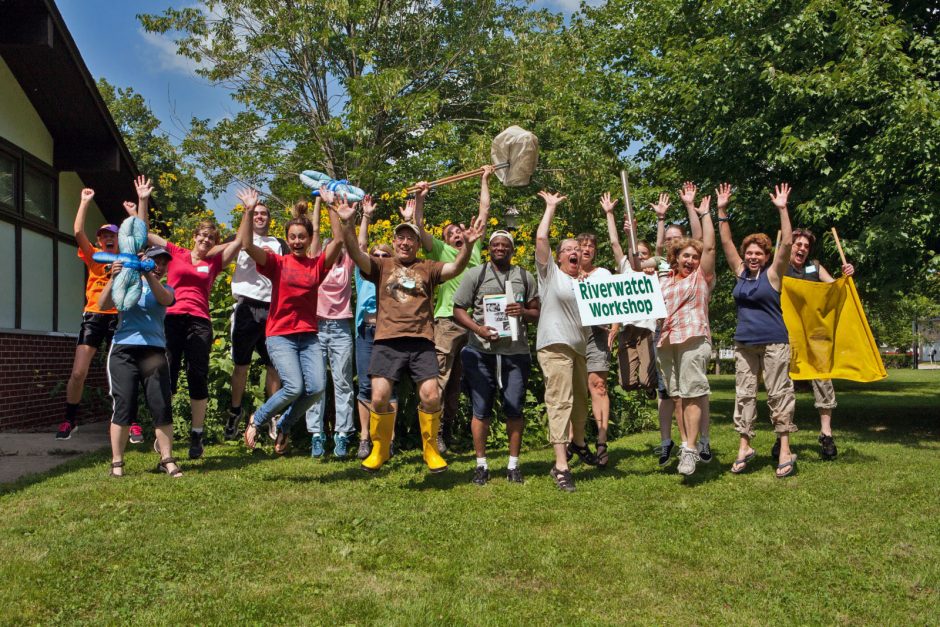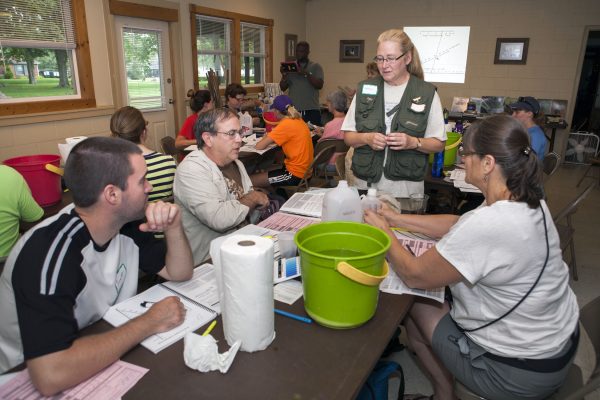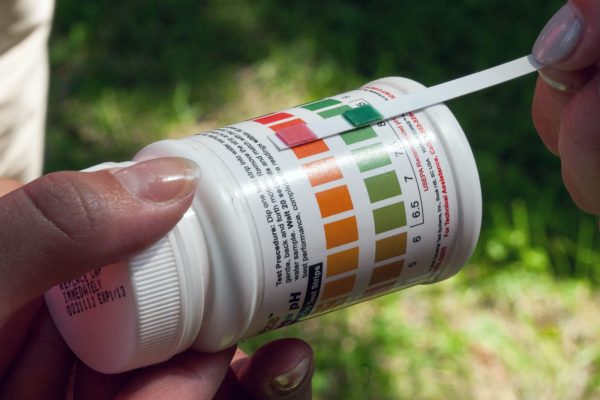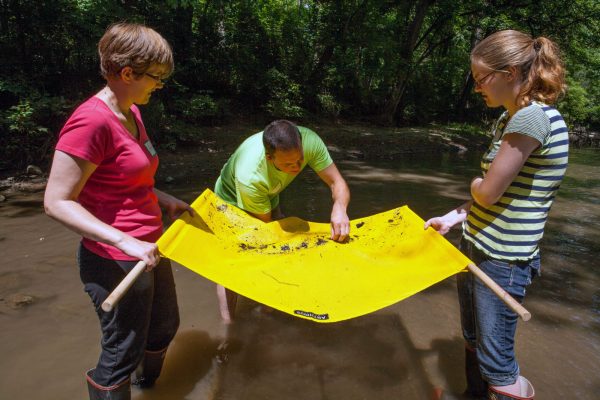Hoosier Riverwatch Recruiting More Citizen Scientists

Riverwatch instructors and volunteers celebrate after their training workshop. (Credit: IDEM/HRW via communication with source)
Hoosier Riverwatch (HRW), a citizen science water quality monitoring program, runs mostly on volunteer power. Overseen by the Indiana Department of Environmental Management (IDEM), the program is expanding and training new citizen scientists who share the desire to pass on cleaner water and more outdoor opportunities for future generations.
“From the beginning, the inspiration was the promotion of citizen stewardship for our shared water resources,” explains Brady Hagerty, IDEM’s digital media manager, on behalf of the Hoosier Riverwatch team. “This continues to be accomplished through educational workshops, websites and a newsletter; providing monitoring equipment and supplies; maintaining an online database; and so forth.”
According to Hagerty, the vision for Hoosier Riverwatch began in 1991 with the conversations and shared interests of two state agencies—IDEM and the Indiana Department of Natural Resources (IDNR)—and various grassroots citizen groups. For the first two or three years, efforts to secure funding for the project failed.
Eventually, in 1995 the project finally took off when the team had enough funds from CINergy and the Indiana General Assembly to purchase a van and supplies. In 1996, federal grant funds from IDEM were sufficient to pay a single staff member. Today, HRW is part of the IDEM Office of Water Quality’s Watershed Assessment and Planning Branch.
Smarter outreach, better results
The HRW mission is to increase public awareness of water quality and related issues, and outreach via citizen science is one of its best tools. Program volunteers train to monitor water quality in the more than 100,000 miles of ditches, drainage ways, streams, and rivers that criss-cross the state.

Instructor Mary Cutler speaks with her students during a Hoosier Riverwatch workshop in Battleground, Indiana. (Credit: IDEM/HRW via communication with source)
“While the dynamics of Riverwatch fluctuates somewhat with economic and educational pressures, it continues to maintain its popularity in the state,” remarks Hagerty. “It enjoys recognition outside of the state, for a variety of reasons. It continues to hold its own with the help of tech-savvy, social media staff at IDEM.”
In many parts of the country, programs like HRW provide invaluable assistance to government agencies tasked with scientific monitoring of water, since there’s far more monitoring than staff can handle alone. HRW plays a similarly important role in Indiana, so the program works to get its citizen scientists ready for the work in the hope that the team will love getting involved and help share HRW’s messaging for years to come.
“Scarcity of monitoring resources is an issue everywhere, so citizens are a great asset,” adds Hagerty. “Initial training is a seven to eight-hour training workshop. There are also training sessions on advanced topics, refresher training and more in-depth training for volunteer instructors.”
Training citizen scientists
HRW training for volunteers generally lasts for a whole day. During that time, participants learn how to measure dissolved oxygen, nutrients, pH, temperature and turbidity in the field.

A Hoosier Riverwatch volunteer studying a stream’s pH level. (Credit: IDEM/HRW via communication with source)
“It works well; concepts are not difficult to grasp,” details Hagerty. “They care about the environment, so they enjoy the work immensely, and are a great multiplier for paid staff.”
Participants also cover chemical monitoring, data analysis and reporting, habitat assessment, macroinvertebrate identification and watershed and pollution sources. By monitoring three major parameters of waterways, their biology, chemistry, and habitat, citizen scientists are better equipped to help determine water quality and get “the big picture” of stream health.
“All monitoring efforts are done by the volunteers,” Hagerty states. “The sampling portion of HRW follows the GREEN (Global Rivers Environmental Education Network) program initiated at Michigan State University in the late 1960s to early 1970s by Dr. William Stapp. The GREEN program and HRW utilize low/appropriate technology; thereby forgoing the expenses associated with laboratories or paid labor.”
Trainees also learn about the connections between the benthic community and water quality.
“Volunteers identify aquatic macroinvertebrates they have collected from the streams,” remarks Hagerty. “These are identified rather broadly into taxonomic orders or families and then released again back to the stream. Professionals, on the other hand, preserve a sample and later identify and count them down to genus, species, and the other five classifications (taxonomy). Volunteers may count them if they wish, but the database only records and calculates them as being present or absent. Locations of macroinvertebrates found is a function of the sampling site being studied.”

Hoosier Riverwatch volunteers collect macroinvertebrates from Burnett’s Creek in West Lafayette, Indiana. (Credit: IDEM/HRW via communication with source)
Participants also learn how to identify invasive species, both plant and animal, such as Asian carp and zebra mussels and invasive aquatic plants elodea and hydrilla.
“Invasive species can be noted during field sampling events, but volunteers are not expected to respond further to the invasive species as part of the HRW program,” clarifies Hagerty. “Invasive plants, algae, animals, insects and even diseases are not uncommon in Indiana. There are other initiatives in the state that spearhead such issues.”
HRW participants enter their data online so they can share their information with IDEM and each other.
“Volunteers are trained and can conduct calculations of the data using training manuals and datasheets,” comments Hagerty. “However, the online database will do the calculations for them once they have properly entered the data (which is their reporting component). Participants are also encouraged to further analyze and share their findings locally, to track trends or show comparisons.”
Once training is over, participants are certified to borrow testing kits from HRW sites, and can monitor the rivers and streams they choose. Ideally, by selecting sites that matter to them, volunteers are more engaged, producing better results.
“There are many beautiful, breathtaking and refreshing places to see in Indiana,” remarks Hagerty. “Getting out to a small stream may help you find your little corner of paradise. Such contact usually leads to better stewardship and even the youngest among us can learn to care for the things we come to value.”
For more information about Hoosier Riverwatch, including how to get involved, visit their website: https://www.in.gov/idem/riverwatch/.
Top image: Riverwatch instructors and volunteers celebrate after their training workshop. (Credit: IDEM/HRW via communication with source)




0 comments